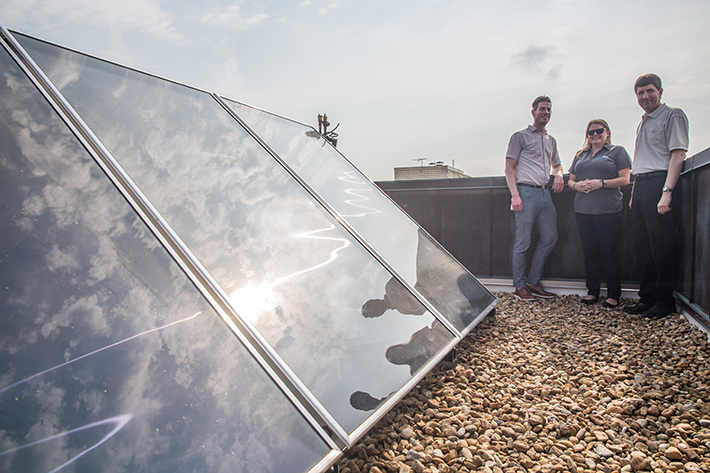The George Washington University debuted its fourth solar thermal hot water system last week on the rooftop of Dakota Hall, the student residence hall at 2100 F St. NW.
The university partnership with energy company Nextility calls for the company to install 17 solar panels to heat the building’s water supply. The solar energy that the panels provide offsets the amount of natural gas the building uses and supports GW’s energy efficiency goals.
The Division of Operations leads the project.
“The university has a commitment to reduce carbon emissions by 2025, and this is one more step in the right direction,” said Sustainability Project Facilitator Mark Ellis.
Nextility has managed all of GW’s solar thermal hot water systems to date including the 2011 installations at 2031 F St. NW, Shenkman Hall and 1959 E St. NW. At the time, the residence halls were collectively the sixth largest solar thermal hot water system in the country, according to the U.S. Department of Energy.
The process of heating the water is simple, according to Doug Spengel, manager of energy and environmental management.
A 50 percent glycol and 50 percent water mixture is heated by circulating through copper tubes and zigzagging through the 4-feet by-8 feet solar panels in a closed loop, Mr. Spengel said. The mix is used to heat the building’s water supply. Heated water is then stored in an 800-gallon insulated flexible tank.
The four solar thermal systems are among a series of renewable energy initiatives that the university has undertaken since releasing the “Climate Action Plan” in 2010.
For example, GW is greening its electricity consumption through the Capital Partners Solar Project, a collaboration among GW, the George Washington University Hospital, American University and Duke Energy Renewables. GW announced in January that 25 percent of its power was sourced from the project’s solar energy site in North Carolina.
The university expects 50 percent of its power to be sourced from solar energy by 2016.
Solar thermal systems are increasingly prevalent among colleges and universities, which have developed climate action plans because they are cost efficient and sustainable, according to the National Renewable Energy Laboratory.
Urban campus residence halls are a great fit for solar thermal hot water installations because the rooftops have enough space for the panels, Mr. Ellis said. Also, they use a large enough quantity of water to result in significant energy and cost savings, he added.
“It’s a win for the university in many ways to adopt solar thermal systems,” Mr. Ellis said. “We plan to continue working toward our energy efficiency goals and hopefully expand solar energy projects to more campus buildings as opportunities arise.”


